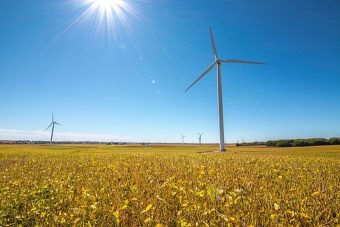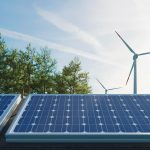
The US Energy Information Administration last week published its latest ‘Electric Power Monthly’ which reveals US renewable energy is locked in a virtual dead-heat with US nuclear energy, each providing roughly 20% of the country’s electrical generation.
However, according to experts looking at recent figures, it’s predicted that nuclear will soon see its percentage share decrease, while renewables are only expected to continue to increase their percentage share of electrical generation.
Each month the US Energy Information Administration (EIA) publishes its ‘Electric Power Monthly’ report which provides an exhausting look at the electricity generation sources across the US. Of recent months it has been important to keep a close eye on this report as renewable energy continues to increase its percentage share of electrical generation, and other generation sources like nuclear and coal begin to feel the effects of gas and renewables greater attractiveness.
Of particular importance this year has been the growth of renewables as compared to nuclear energy. Specifically, EIA figures in June showed that renewable energy generation in March and April beat out nuclear energy for the first time ever. Fast-forward and it turns out that over the first half of this year, renewables beat out nuclear in March, April, and May. Further, across the whole of the first half of 2017, nuclear and renewables both provided roughly 20% of the total electrical generation for the US — 20.05% for renewables and 20.07% for nuclear.
Ken Bossong, who runs the Sun Day Campaign, highlighted the EIA’s figures as he does pretty much each month, and dug further into the EIA’s numbers to see what things look like in the future.
According to the EIA, “monthly nuclear electricity generation will surpass renewables again during the summer months of 2017 and that nuclear will generate more electricity than renewables for all of 2017.” However, Ken Bossong is less likely to jump on this particular bandwagon right away. Specifically, the growth trends of both nuclear and renewables don’t line up perfectly well with the EIA’s predictions — renewables’ growth continues to expand while nuclear is stagnating, if not outright declining. Looking at the numbers, renewables electrical output across the first half of 2017 was 16.34% higher than it was during the first half of 2017, whereas nuclear output dropped by 3.27%. In June alone, electrical generation from renewable energy sources was 27.15% higher than in June 2016, while nuclear dropped by 0.24%.
“Everyone loves a horse race,” noted Ken Bossong, Executive Director of the SUN DAY Campaign. “However, the smart money is now on renewables to soon leave nuclear power in the dust.”
“Nuclear power is in irreversible decline in the US, due to rising costs and failing economics of new and existing reactors, alike,” added Tim Judson, executive director of the Nuclear Information and Resource Service. “Last month’s cancellation of half the new reactors under construction in the U.S. means that gap is going to be wider than projected, and accelerating.”
There is growth across the whole spectrum of renewable energy sources — most notably in the solar sector, which when utility-scale solar is combined with small-scale solar, has grown by 45.1% over the first half of this year when compared with a year earlier. Hydropower is up 16.1%, wind is up 15.6%, and geothermal is up by 3.2%.
On the other hand, nuclear in the US is “bleeding cash” and numerous facilities are being shuttered or planned-expansions are being halted. In July the cancellation of the Summer 2 and 3 reactors in South Carolina joined Duke Power’s announcement that it was cancelling construction of the twin William Lee reactors. Meanwhile, it is expected that the Vogtle 3 and 4 reactors in Georgia are also coming up on the chopping block. This month, Bloomberg New Energy Finance predicted that 55% of America’s nuclear plants are costing their owners $2.9 billion a year.
Source: cleantechnica.com



